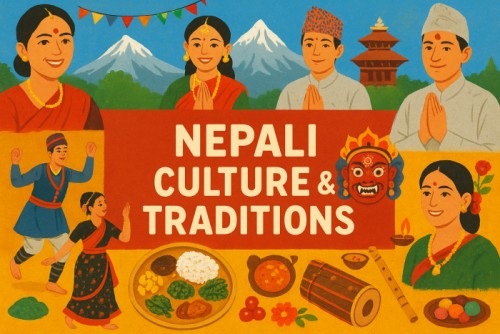
🌺 Nepali Culture and Traditions: Festivals, Food, and Customs
-
- 0 Share
- 326 Views
Nepal is a small country with a big heart, rich in culture and traditions. From the mighty Himalayas to the vibrant streets of Kathmandu, every corner of Nepal reflects its unique identity. The people of Nepal are deeply connected to their cultural heritage, passing traditions from one generation to another. These traditions are not just practices—they are a way of life that keeps families and communities united.
✨ Nepali Festivals and Celebrations
Nepal is often called a “land of festivals”, and almost every month brings a new celebration. Festivals in Nepal are colorful, joyful, and full of meaning.
Dashain – The biggest festival in Nepal, symbolizing the victory of good over evil. Families reunite, elders bless the young with tika and jamara, and the skies fill with kites.
Tihar – Known as the festival of lights, where animals like dogs, cows, and crows are honored, and brothers and sisters celebrate their sacred bond during Bhai Tika.
Holi – The festival of colors, where people splash water and powders, spreading joy and happiness.
Other cultural festivals – Teej, Maghe Sankranti, Lhosar, Chhath, and Indra Jatra all show the diversity of Nepali culture and traditions.
👗 Traditional Nepali Dress and Ornaments
Nepali traditional dress is diverse because Nepal is home to many ethnic groups, and each community has its own beautiful attire.
Daura Suruwal and Dhaka Topi – Worn by men and considered the national dress of Nepal.
Gunyu Cholo – A traditional attire for women, especially in rural areas.
Sari and Kurta Suruwal – Worn by women during festivals and ceremonies across Nepal.
Gurung Dress – Colorful traditional outfits with unique ornaments, representing the Gurung community.
Newar Dress – Haku Patasi (black sari with a red border) for women and Taplan for men.
Sherpa Dress – Warm clothing like Bakhu, designed for the cold Himalayan regions.
Tharu Dress – Bright, vibrant clothes with heavy jewelry, especially used in cultural dances.
Tamang and Magar Dresses – Each with its unique style, embroidery, and cultural meaning.
During weddings and festivals, women often wear red saris with tika, pote, bangles, and gold ornaments, symbolizing love and prosperity. Every outfit not only looks beautiful but also tells the story of the community it belongs to.
🍲 Nepali Food Culture
Food is at the heart of Nepali culture.
The national dish, Dal Bhat Tarkari, provides energy for both villagers and mountain climbers.
Popular foods include momo, sel roti, yomari, dhido, and gundruk.
Festivals have their own special dishes, like sel roti during Tihar or yomari during Yomari Punhi.
The taste of Nepali food reflects love, tradition, and togetherness.
🎶 Nepali Arts, Music, and Dance
Nepali culture is rich in art, music, and traditional dance.
Folk dances like Lakhe, Maruni, and Deuda are performed during celebrations.
Instruments like the madal, sarangi, and bansuri bring soulful sounds to festivals and gatherings.
Nepali handicrafts, wood carvings, and paintings show the deep history and skills of our ancestors.
🌿 Nepali Customs and Traditions
Nepali traditions guide people from birth to marriage and beyond.
Pasni – The rice-feeding ceremony for babies.
Bratabandha – A coming-of-age ritual for boys.
Weddings – Filled with songs, dances, and blessings from families and relatives.
Respecting elders, staying close to family, and living in harmony are the core values of Nepali culture.
💫 Conclusion: Preserving Nepali Culture and Traditions
Nepali culture is a living treasure filled with festivals, foods, music, and customs. These traditions are the roots of our identity. In today’s modern world, it is important for the younger generation to preserve this cultural heritage so the beauty of Nepal continues to shine across the world.
Please
